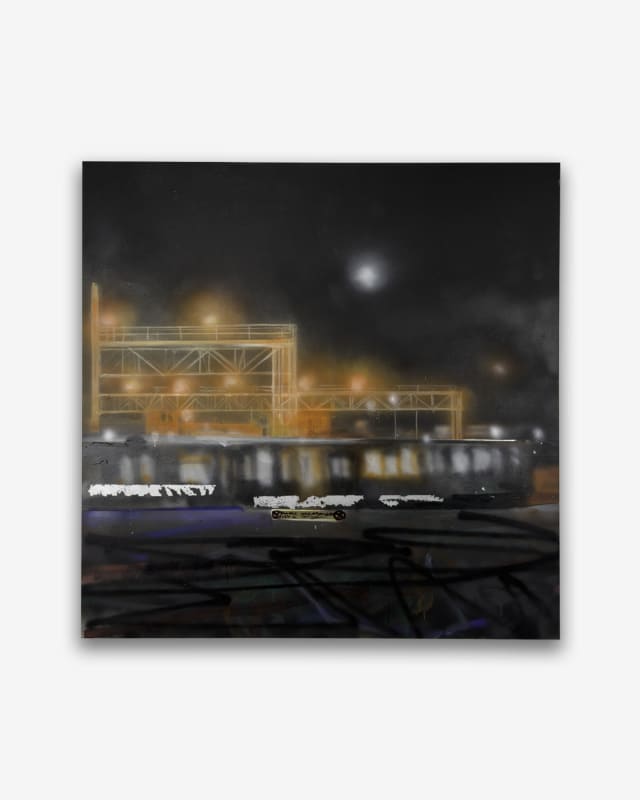This is not street art.
It’s the continuation of a visual language born on steel and carried through generations.
A discipline disguised as rebellion.
In the early months of summer 2025, the ballroom of the Chambers Hotel, once exclusive and now a mostly dormant luxury space above Hennepin Avenue, became a painting studio. As the exhibit Daydreaming at Midnight unfolded, SHOCK UC MSK moved in with canvases, markers, photos, and paint. He was riding the momentum of Treasure, a radical self-produced exhibition staged inside the ruins of the Pillsbury Flour Mill in Springfield, Illinois, in October 2024. That show, like the building and the artist, was on the verge of transformation.
What followed were two separate and spontaneous residencies intertwined with SHOCK’s first major exhibition in Minneapolis. The first, inside the Chambers ballroom, was both public and private. He painted by night and invited the city to interact with the evolving exhibition by day.
But this space, like others before it, was temporary. As the Chambers chapter closed, the artist pivoted. With help from longtime collaborator HOTTEA, he relocated his in-process canvases to a back building off SE Hennepin Avenue, a raw, barely maintained industrial space. No lease was signed, though one was attempted. The building’s manager, with a polite contempt hidden in the language of the lease, made that impossible. It wasn’t the fate that was meant to be. Still, the artist had already set up shop. Canvases were delivered. Materials: spray paint, rollers, house paint, markers all seemed part of the artist himself. They traveled with him like companions.
Then life happened. He stepped away for a few days.
When he returned, everything was gone.
What followed feels impossible to make up.
Distraught but intent on expressing what had been taken mid-process, the artist began again. Late one night, or maybe early morning, around our nation’s Independence Day, he returned to work with precision and focus. While painting, he noticed something: a massive green vault-like door just outside the studio, looming. Guided by intuition, hearing a heartbeat like Edgar Allan Poe, he began dismantling it, hinge by hinge, screw by screw. Undeterred by the weight, the labor, or the July heat, even at midnight, he persisted.
Inside the tomb were the paintings, the paint cans, the tools, and the journals, along with a few other artifacts likely “appropriated” by the manager in earlier episodes.
He dragged everything back out into the open, reassembled the door, rebuilt the studio like a puzzle, and began again. Over the next several weeks, SHOCK created in the building like a ghost. To most who passed through, he was invisible. But he saw and heard everything.
The paintings that emerged from this space are the most focused and significant of his career to date.
The most important picture from this chapter, Howard Yard 2005, 2025, is what the artist refers to as Graffiti Realism. Rendered entirely in spray paint, it depicts the train yard outside his childhood home in Chicago. A painting of the artist’s first studio. A space where steel freight trains became rolling canvases, and the painter worked with full awareness of the world around him yet remained unseen.
A night scene lit from within, it functions as both memory and map, a psychic landscape built from atmosphere and experience. There is no text, no overt graffiti, yet the philosophy of the writer is everywhere: in the repetition, the layering, the transformation of steel and memory into something radiant.
These paintings are not remnants of rebellion.
They are declarations of presence.
They speak to what it means to be seen, to lose everything, to recover it, and to make something new. To repeat that process, and to create no matter what.
This is not street art.
This is a painter who speaks in code and light.
A writer who reclaims space.
A man who disappears, then reemerges, clearer than ever.
Why This Matters
Graffiti is not a genre; it is an ism the last great movement in contemporary painting to emerge from lived experience rather than theory.
Born on trains and city walls, it built its own visual language: rhythm, repetition, and reclamation. Its earliest practitioners were engineers of identity, transforming industrial surfaces into sites of communication and authorship.
What follows is what we now call Post-Graffiti Painting: a generation of artists translating that language from motion to stillness, from the street to the studio, from code to light.
SHOCK UC MSK stands firmly within that lineage. His work does not borrow from graffiti; it extends it, preserving the discipline, danger, and devotion that defined its origins while evolving its form.
The Light They Didn’t Pay For marks this transition with rare clarity:
a bridge between the industrial ruins of Springfield, the haunted studios of Hennepin Avenue, and the painter’s lifelong search for freedom within form.
Graffiti has always been the most contemporary of the isms, and this is its next chapter.

